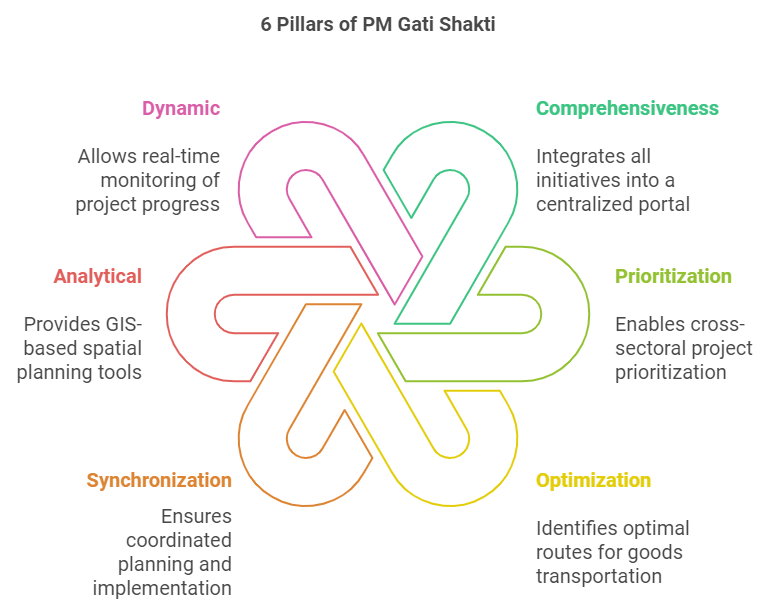Facts for UPSC Mains
PM GatiShakti National Master Plan
- 14 Oct 2025
- 8 min read
Why in News?
On the occasion of celebrating 4 years of the PM GatiShakti National Master Plan (NMP), the government has opened its PM GatiShakti portal to the private sector, aiming to enhance last-mile delivery services and infrastructure development.
- PM GatiShakti portal is developed by Bhaskaracharya National Institute for Space Applications and Geo-informatics (BISAG-N).
What is PM GatiShakti National Master Plan?
About:
- Launched in October 2021, it is a Rs 100 lakh crore investment initiative for infrastructure development over the next five years.
- It promotes integrated development across seven economic drivers—railways, roads, ports, waterways, airports, mass transport, and logistics—supported by energy, IT, water, and social infrastructure.
Objective:
- It aims to cut logistics costs through integrated infrastructure planning.
- Acting as a digital backbone, it bridges macro-level planning and micro-level implementation, links existing schemes (Bharatmala, Sagarmala, UDAN), and connects economic zones to boost business competitiveness.
Foundational Pillars:
Key Features:
- Geospatial Data Platform: It integrates 200+ layers of geospatial data onto a centralized portal, enabling users to visualize multi-layered data for a holistic view of existing and planned assets.
- Economic Hubs: Targets textile clusters, pharmaceutical hubs, defence corridors, and agricultural zones to boost productivity.
- Tech-Driven Planning: Uses advanced spatial tools and ISRO satellite imagery by BISAG-N for data-driven project management.
Targets:
- Aviation Infrastructure: Plan includes 200 new airports, heliports, and water aerodromes to support aviation.
- Renewable Energy: Increase renewable capacity to 225 GW by FY25 and complete 17,000 km of gas pipelines.
- Power Grid Expansion: Extend the power grid with 454,200 circuit km of lines.
- National Highway Network: Aim to expand to 200,000 km of national highways.
- Rail Cargo Capacity: Target to grow rail cargo capacity to 1,600 tons by FY25.
Key Achievements:
- Unified Government Platform: Integrates 44 Central Ministries and 36 States/UTs on a single platform with over 1,600 data layers for cohesive planning.
- Project Evaluation: The Network Planning Group (NPG) has evaluated over 200 big-ticket projects based on PM GatiShakti's principles of multimodal integration and last-mile connectivity.
- Social Sector Development: The platform is being extended to plan social infrastructure—identifying gaps and enabling better placement of schools, hospitals, and anganwadis, especially in remote areas.
- Boosting Trade & Logistics: Aligned with the National Logistics Policy, 2022, it has helped improve India's rank on the World Bank Logistics Performance Index to 38th in 2023, a significant rise from 44th in 2018.
What are the Key Challenges Facing PM GatiShakti, also Suggest Measures to Address Them?
|
Challenges (Mnemonic: BLOCK) |
Way Forward (Mnemonic: SCALE) |
|
B - Bureaucratic Silos: Deep-rooted silos and bureaucratic resistance hinder the seamless data sharing and inter-ministerial coordination that GatiShakti requires. |
S - Standardize Data Systems: Enforce standardized data protocols, establish clear data ownership and accountability, and mandate regular audits for accuracy and timely updates. |
|
L - Land & Legal Hurdles: Despite integrated planning, land acquisition and obtaining numerous statutory clearances remain a major source of project delays. |
C - Create Collaborative Incentives: Create performance metrics that reward inter-departmental collaboration and successful integrated project outcomes. |
|
O - Operational Data Gaps: Different ministries/states may have varying data standards, formats, and update frequencies, leading to unreliable insights. |
A - Advance Technical Training: Launch nationwide training programs for officials at all levels. Develop simplified user interfaces and provide dedicated technical support cells to ensure effective platform utilization. |
|
C - Capacity & Skill Shortage: Many state and local agencies lack the technical infrastructure and skilled personnel to effectively use the advanced GIS and analytics platform. |
L - Link Approval Processes: Use GatiShakti to identify land-related issues at the planning stage. Integrate with other government portals (e.g., PARIVESH) for faster, parallel processing of clearances. |
|
K - Kinetic Action Delay: Ensuring that the real-time data from the platform leads to timely interventions and corrective actions on stalled projects is a challenge. |
E - Enforce Monitoring Mechanisms: Strengthen the Network Planning Group (NPG) mandate to include monitoring and troubleshooting. Implement an escalation matrix for unresolved bottlenecks. |
|
Drishti Mains Question: Evaluate the significance of PM GatiShakti in improving last-mile connectivity and reducing logistics costs. |
Frequently Asked Questions (FAQs)
1. What is the PM GatiShakti National Master Plan?
Launched in October 2021, it is a Rs 100 lakh crore initiative integrating 16 ministries for coordinated infrastructure planning and improved logistics efficiency.
2. What are the key engines of growth under PM GatiShakti?
Railways, Roads, Ports, Waterways, Airports, Mass Transport, and Logistics Infrastructure, supported by energy, IT, bulk water, and social infrastructure.
3. What are the major achievements of PM GatiShakti?
Integration of 44 ministries and 36 states/UTs, evaluation of 200+ projects, enhanced social infrastructure planning, and improved World Bank Logistics Performance Index ranking to 38th in 2023.
UPSC Civil Services Examination, Previous Year Questions (PYQs)
Prelims
Q. With reference to ‘National Investment and Infrastructure Fund’, which of the following statements is/are correct? (2017)
- It is an organ of NITI Aayog.
- It has a corpus of `4,00,000 crore at present.
Select the correct answer using the code given below:
(a) 1 only
(b) 2 only
(c) Both 1 and 2
(d) Neither 1 nor 2
Ans: (d)
Q. In India, the term “Public Key Infrastructure” is used in the context of (2020)
(a) Digital security infrastructure
(b) Food security infrastructure
(c) Health care and education infrastructure
(d) Telecommunication and transportation infrastructure
Ans: (a)
Mains
Q. “Investment in infrastructure is essential for more rapid and inclusive economic growth.” Discuss in the light of India’s experience. (2021)







